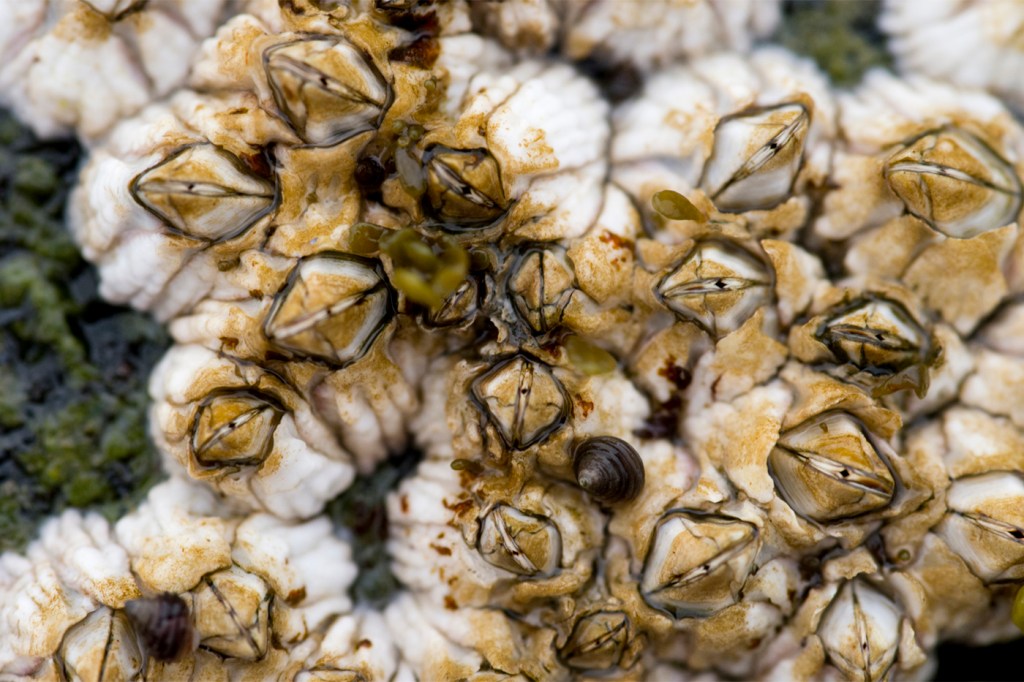Barnacle-inspired polymers could present new way to design antibiofilm materials, researchers say

Talk about a wave of inspiration.
Scientific literature has shown that barnacles that cling to rocks at the seashore use naturally occurring chemicals to clear rock surfaces of bacteria in preparation for laying down their sticky “glue.”
Since bioengineering professor Abraham Joy’s lab had already designed a synthetic polymer that adheres well to wet surfaces, researchers wondered if they could use the material to loosen bacteria from their moorings in other settings, including human tissue and industrial pipes.
“We were thinking, can we use that idea to almost simulate what barnacles are doing and test out materials to see if they have similar actions,” says Joy, who became chair of Northeastern University’s Department of Bioengineering in January.
“When we did it, we were surprised it works very well” against certain bacterial biofilms, he says.
Biofilms are a collective of microorganisms that can grow on different surfaces and could include bacteria and fungi.

A research paper he co-authored in the Journal of the American Chemical Society showed the polymer was able to remove nearly all the biofilm housing a bacteria that can cause antibiotic resistant infections, Pseudomonas aeruginosa.
“This research tells us that we have potentially a new way of thinking about how to design antibiotics,” Joy says.
It’s possible that in the future the polymers can be applied in liquid form to biofilms in wounds that are chronic or slow to heal, he says. There could also be industrial applications for clearing bacterial contamination out of pipes and medical devices.
Featured Posts
Clearing out the biofilms that house bacteria
Joy says the research is not actually about killing bacteria, but about disrupting the interactions between biofilms that house them and surfaces on which they are living.
“We’re not looking at killing the bacteria,” he says. “‘We’re just saying, ‘How do you address the removal of the biofilms by themselves?’
“Think of biofilm as a house and bacteria as people inside a house. We’re not doing anything to the people in the house. We’re just working with the exoskeleton or the scaffolding or structure of the housing. We’re just making that housing weaker.”
Many forms of bacteria lay down biofilms when they settle on a surface, Joy says.
He says 60% to 80% of wounds have biofilms present, which presents a treatment challenge since the bacteria in biofilms are dormant and do not respond effectively to the cocktail of oral antibiotics typically given in a hospital. Those antibiotics are designed to work on metabolically active bacteria.
“You need something to clear out the biofilms,” Joy says.
When that happens the bacteria are exposed and become metabolically active, he says. “Then your conventional drugs can start to work.”
Joy says the next step is to apply the polymers, which are a type of polyester, to infected wounds in liquid form to see whether it is effective on live tissues.
“If this is successful, it will be a novel method of addressing wound biofilms,” he says.
Targeting Staph and E. coli biofilms
But while the polymer used in his research removed 99% of Pseudomonas aeruginosa biofilm biomass from underwater surfaces, it was not as effective at removing biofilms housing Staph and E. coli.
The composition of the biofilms are different, Joy says, noting that the former contains more carbohydrates while the latter two are more protein based.
“What we’re trying to do now is to understand the mechanism of how exactly this works,” he says. “We’re trying to see what components of the biofilm the polymer is really interacting with.”
“Can we change the polymer composition a little bit? Can we design polymers that are specific for Staph aureus biofilms?” Joy asks.
“Our hope is that we can tailor, sometime in the future, polymers that are specific for specific bacteria,” he says. “Then you have a powerful tool that you can use to address multiple scenarios of bacteria in different situations.”
A Goldilocks viscosity
“The physical properties of the material have to be just right to enable it to interact well with the components of the biofilm,” Joy says.
He says to think of biofilm as grass on the lawn and the polymer as the solution that loosens it so the blades can be pulled out more easily.
“If the polymer is too hydrophobic,” or viscous, “it just sits there,” says Joy, whose lab tested the polymer solution by applying it at a 10-degree angle. “If it’s too hydrophilic,” or diluted, “it just washes away” without affecting the biofilm.
“Our hope is that this research will start a conversation about designing antibiotics that take into account the physical and mechanical properties of biofilms,” he says.
“Of course we’re going to test it clinically, but I also think it gives a new framework to think about how to address the problem.”











